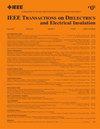Nanosecond Discharge in Non-Boiling Liquid Nitrogen
IF 3.1
3区 工程技术
Q2 ENGINEERING, ELECTRICAL & ELECTRONIC
IEEE Transactions on Dielectrics and Electrical Insulation
Pub Date : 2025-03-20
DOI:10.1109/TDEI.2025.3571687
引用次数: 0
Abstract
Nanosecond discharge has been studied in non-boiling liquid nitrogen. The discharge is initiated in the gap in the central conductor of a coaxial waveguide with an impedance of非沸腾液氮的纳秒放电
对非沸腾液氮的纳秒放电进行了研究。放电是在阻抗为的同轴波导的中心导体的间隙中开始的 $50~\Omega $ . 差距在10 -以内变化 $100~\mu $ m.波导的电介质和放电介质为常压和温度为65k的未沸腾的液氮。电压脉冲的幅值为+/ -12-25 kV,持续时间为7 ns,电压上升时间为150 ps,发现放电电流的前缘小于80 ps $\nu _{i}$ 大于 $7.5\cdot 10^{{10}}$ ${\mathrm {s}}^{-{1}}$ 电离速率常数 ${k} _{i}$ 大于 $4.2\cdot 10^{-{12}}$ 立方厘米 ${\mathrm {s}}^{-{1}}$ 在不沸腾的液氮中,温度为65k。在波导放电间隙后检测到一个振幅约为10 kV、持续时间约为150 ps的通过电磁耦合波。对电磁耦合波的形成进行了数值模拟。测量了放电延迟时间与间隙电场的关系。的形成 $20~\mu $ 在电极表面发现了M大小的侵蚀坑,表明微爆炸过程可能在放电机制中起作用。
本文章由计算机程序翻译,如有差异,请以英文原文为准。
求助全文
约1分钟内获得全文
求助全文
来源期刊
CiteScore
6.00
自引率
22.60%
发文量
309
审稿时长
5.2 months
期刊介绍:
Topics that are concerned with dielectric phenomena and measurements, with development and characterization of gaseous, vacuum, liquid and solid electrical insulating materials and systems; and with utilization of these materials in circuits and systems under condition of use.

 求助内容:
求助内容: 应助结果提醒方式:
应助结果提醒方式:


